








|
The following article is based on a transcript of a presentation I gave on March 14th / 96. The presentation was titled "Telepresence and Digital/Physical Body : gaining a perspective", and was given to a group of university fine-art students at the University of Saskatchewan, Canada. Included in the following article are images of the slides made for the talk, and a small QuickTime video clip of the presentation. Please note the original context and intent of this article -- it was given to a group of artists with no apparent knowledge or interest in either telerobotics or digital presence. The original presentation glossed over many nuances within each of the projects defined, and was presented to give a quick and personally opinionated general overview of the area. This presentation was not prepared as an academic proposal, but gives those who are not familiar with this arena a starting point to explore for themselves. This document will not remain static. I do not claim to "know everything" about the issues I am interested in, but wish to encourage dilogue in this arena. Please do not hesitate to drop me a note if you disagree with my statements. An important purpose of this website for me is to stimulate dialogue. Even though this presentation is out-of-context here, I hope my decision to put this lecture into this format will expand and promote discussion into this area on the web.
|
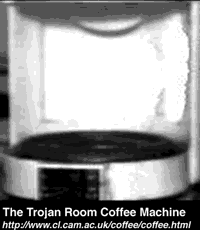
|
i n t r o d u c t i o nThe lecture I am about to present is titled "Telepresence and Digital/Physical Body". Although this discussion is presented in a "studio art" and "art theory" context, the core examples of this discussion are not from an art-based sphere. The main projects analyzed are primarily from the worlds of science and technology, and are mentioned to establish four basic points:
|
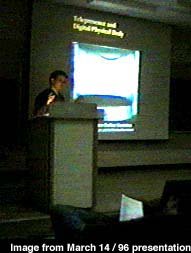 |
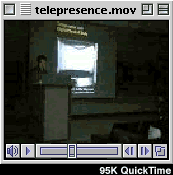
[ the audience stays silent... ]
Let me give you a clue... does anybody know what a television, telephone, and a telescope have in common?
[ the audience appears either non-talkative or non-thinking, remaining quiet... ]
Telescopes, televisions, radios and telephones all generally posess a form of telepresence. Strictly stated as a definition, the term "telepresence" will be defined in this presentation as : "a technologically mediated remote presence".
Telepresence is, in fact, a by-product of the technological age that is happening around us. At the basis of this concept lay two primary concepts -- namely 1). communication and 2). the self. Although the concept of telepresence is not new -- perhaps as old as the invention of transportable written language -- I will focus on the digital extension of this field, an area which introduces some new issues related to theory of reality, the self, communication, and virtual existence.
Many pioneers of video art -- such as Dan Graham and Les Levine -- saw and used the potential of the video medium to explore new theories concerning telepresence in the 1970's. The new medium of video provided a kind of transportable sense of reality on videocassete. Particularily in Dan Graham's early work -- which used mirrors, videocameras, and time-delay -- challenged and explored concepts of perception, reality, and the self.
I will not expand further into the history of telepresence and artmaking here. However, it is clear that the histories of photography and video art hold strong elements of theory of telepresence in them when analyzed.
[ By this time the image of the Tojan Coffee Room coffee pot (see above) has been projected at the front of the room for some time with no explanation of its purpose or context ]
For many years, digital-based experience involved a text-only realm. Early users of digitally networked systems began information exchange via text-only documents: e-mail. Through the transference of text, the fundamental elements of language represented as ascii characters formed what is now known as "the internet" -- about 40 million individuals connected via computer network.
Although this digital space was an active arena, it still remained generally "virtual". The user, sitting down at their computer "floats in digital space" once connected. Their physical body becomes unimportant -- being disembodied from their physical sense. This mind/body split produces what I will term as "a disembodied digital self". By this I mean that interactions done on the computer stay within "computerspace". In this sense, one's telepresence or experience as a digital mind holds a weak reference to physical reality.
However, in the late 1980's, the Trojan Room Coffee Pot [ pictured above ] marks one of the first attempts to re-introduce a physical sense of actual sight back into the disembodied digital self. Although images had existed in digital space before the Trojan Room Coffee Pot, the banal and apparently trivial Pot was likely the first "eye of cyberspace".
[ For more information about the Trojan Room Coffee Pot, make a short visit to the project website ]
In summary, the Tojan Room Coffee Pot marked the beginning of an interesting field, trying to re-introduce a physical attribute back into the disembodied digital self. Slowly constructing a sense of digital/physical body, telepresence is now longer completely virtual.
The most interesting potential of this field is perhaps the ability to disseminate digital images to such a wide audience: the reproducibility of the image to hypothetically 40 million internet users at the same moment. In a digital/physical body experience -- if the experience or reality of the individual could be digitized and put online, the experience or sight could be made virtually omnipresent.
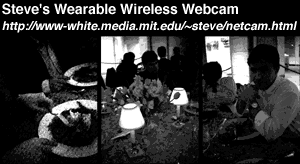 A few years after the Trojan Room Coffee Pot, a much more interesting and bizzare implementation of this practice and theory was contructed -- "Steve's Wearable Wireless Webcam".
A few years after the Trojan Room Coffee Pot, a much more interesting and bizzare implementation of this practice and theory was contructed -- "Steve's Wearable Wireless Webcam".
Intentionally confrontational, the Wearable Wireless Webcam is worn atop Steve's head, transmitting live images of his experiences over the internet. Like digitally crawling into someone's head, the Wearable Wireless Webcam is likely the most extreme example of a private view made public. Wearing the camera daily for over a year, "Steve" pushes the boundaries of image-taking and transmission, privacy, and sanity. With the proliferation of sureveillence cameras in malls, confectionaries, bank machines, freeways, and public streets, it is a clever concept to attempt to take this theory to its radical extreme.
[ For more info about the Wearable Wireless Webcam, take a short trip to the project website ]
It has not been brought to my attention any other project which confronts these issues so directly. I mean, what does Steve do when he goes to the bathroom?
[ the audience emits laughter ]
Even though the possible implications of such device as a "wearable wireless webcam" are tremendous, the digital body -- as it were -- remains a passive entity. The telepresence of once viewing &Steve's" experiences does nothing except watch: it physically does nothing except gaze.
However, there have been attempts at re-introducing the physical-ness of the disembodied digital mind. The individual who has metaphorically shed their physical body upon entrance into digital space, has been expereimentally re-constituted into a physical format. The next phase of this lecture will explore this topic -- the actual physical re-manifestation of the digital body.
Perhaps this concept will be clarified with an example:

Conceptually the Tele-Garden is a re-constitution of the dismbodied digital mind into a physical format. Users from around the world via the internet can physically control a robotic device. Practically, it is an industrial robot arm amidst a bed of dirt. This robotic device has a live camera on it, and allows the user to plant seeds and water them over an extended period of time. The whole thing is hooked up to the internet, and individuals -- in Saskatoon for example -- can go to their computers and actually plant a real in a tub of dirt in California, and come back to it and track their plant's development.
The question that's likely ringing through your head is: "What's the use of all the technology?" -- "What is the use of going onto your computer to plant a seed in a tub of dirt in California with a robot arm?" This is a valid question.
The one criticism I personally have of the Tele-Garden is that to the casual viewer/user the robotic device remains a "gadget". It appears as if the project is infatuated with its own technology. Although very impressive technically, the project appears to fall victim of the "'effect' effect" (Rafael Lozano-Hemmer in Perverting Technological Correctness - Leonardo, April / 96) -- a state in which the technical 'special effect' of tele-operation becomes the focus of the project. Although there are conceptual "sound bites" (Voltaire, Neil Postman), the project -- on a general-user level -- seems to avoid some of the exciting theoretical issues that could be analyzed. It is unfortunate that such a successful and acclaimed project does not provide more clues to its theoretical possibilities.
[ for a more detailed description of the Tele-Garden, take a short visit to the project website and find out for yourself if what I'm saying seems representative of the project ]
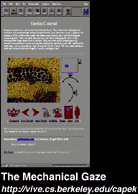
[ for a more detailed description of the The Mechanical Gaze, take a peek at the project website ]
In his second experiment pertaining to telepresence and Digital/Physical Body, Eric Paulos is now -- as we speak -- building what he believes to be the ideal manifestation of the re-materialized digital self: a blimp.
[ the audience chortles slightly... ]
This device -- like a shell of a physical body -- would be controlled remotely by a user, and could literally 'float' around a physical space by the commands of the remote user. The tele-operated blimp would be a physical carrier of your digital telepresence which could do many physical things: hear, speak, see, and move. Almost out of a science-fiction world, the "Interfacing Reality" project is explicitly attempting to re-embody the once disembodied digital mind. By enabling his devices to navigate through a spaces not possible by physical human bodies (through flying), Paulos' research exemplifies a common goal of many telepresence researchers: to use tele-technology as an extension of the user's physical body.
[ quickly explore Eric's blimp website for more information about the project ]
It is important -- in my opinion -- that artists and creative individuals at least have an informed perspective of this field. Hopefully through this discussion I've introduced you a bit to some new theories of the self and digital media, and although I do not expect you all to share the a strong interest or repulsion toward such work, I feel that the concept of telepresence and physical/digital body is a useful piece of knowledge in a world that is becoming increasingly mediated by technology.
Any questions? [ feedback/comments/flames welcome ]